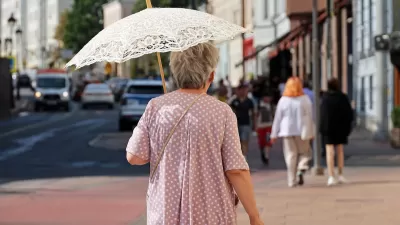The state has the most heat-related hospital visits in the nation, but efforts to create protections for outdoor workers and other vulnerable residents have been stymied by state legislators.

Florida is seeing the highest number of heat-related illnesses in the country, reveals a new report from the Florida Policy Institute.
As Ashley Miznazi explains in Governing, “The state saw more than 26,000 emergency room visits and 5,000 hospitalizations for heat-related illness between 2018 and 2022, according to the most recent U.S. Centers for Disease Control data compiled by the Orlando-based institute, a non-profit organization that researches health, education and other policy issues.” In a similar period (2017 to 2021), roughly 150 people died of heat-related causes in the state.
An accurate count of heat-related deaths is not always available, “with heat’s impact watered down in official statistics,” Mizrazi notes. “For example, when someone is hospitalized for a condition worsened by heat, their provider typically records only the chronic illness as a cause. The new report also highlights that some Floridians, such as outdoor workers who may fear retaliation from employers for reporting an incident, are also excluded from national statistics.”
With extreme heat expected to become a more widespread problem, understanding heat deaths and who is at risk is a crucial public health issue. Yet in Florida, state lawmakers recently passed a law blocking local governments from enforcing any heat-related protections for workers.
In addition to the half million outdoor workers in the state, the report notes that over 5.7 million Florida residents are “socially vulnerable” to heat due to disability, a lack of health insurance, and a lack of cooling in their homes.
FULL STORY: Florida Has the Most Heat-Related Illnesses in the U.S.

Alabama: Trump Terminates Settlements for Black Communities Harmed By Raw Sewage
Trump deemed the landmark civil rights agreement “illegal DEI and environmental justice policy.”

Study: Maui’s Plan to Convert Vacation Rentals to Long-Term Housing Could Cause Nearly $1 Billion Economic Loss
The plan would reduce visitor accommodation by 25% resulting in 1,900 jobs lost.

Why Should We Subsidize Public Transportation?
Many public transit agencies face financial stress due to rising costs, declining fare revenue, and declining subsidies. Transit advocates must provide a strong business case for increasing public transit funding.

Paris Bike Boom Leads to Steep Drop in Air Pollution
The French city’s air quality has improved dramatically in the past 20 years, coinciding with a growth in cycling.

Why Housing Costs More to Build in California Than in Texas
Hard costs like labor and materials combined with ‘soft’ costs such as permitting make building in the San Francisco Bay Area almost three times as costly as in Texas cities.

San Diego County Sees a Rise in Urban Coyotes
San Diego County experiences a rise in urban coyotes, as sightings become prevalent throughout its urban neighbourhoods and surrounding areas.
Urban Design for Planners 1: Software Tools
This six-course series explores essential urban design concepts using open source software and equips planners with the tools they need to participate fully in the urban design process.
Planning for Universal Design
Learn the tools for implementing Universal Design in planning regulations.
Smith Gee Studio
Alamo Area Metropolitan Planning Organization
City of Santa Clarita
Institute for Housing and Urban Development Studies (IHS)
City of Grandview
Harvard GSD Executive Education
Toledo-Lucas County Plan Commissions
Salt Lake City
NYU Wagner Graduate School of Public Service





























